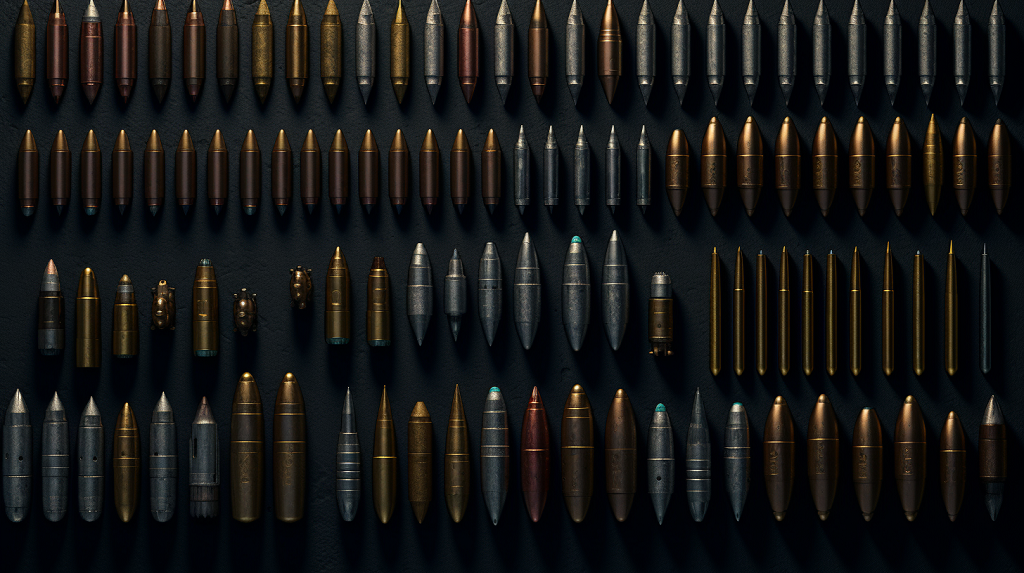Types of Bullets: Exploring Projectile Varieties for Firearms

Firearms fire bullets, which play a vital role in determining accuracy, range, and effectiveness. There are various types of bullets available, each designed for specific purposes and applications. In this article, we will explore different types of bullets, their characteristics, and common uses in firearms.
Table of Contents
- Table of Contents
- Full Metal Jacket (FMJ) Bullets
- Hollow Point (HP) Bullets
- Soft Point (SP) Bullets
- Ballistic Tip Bullets
- Open Tip Match (OTM) Bullets
- Boat Tail Bullets
- Armor-Piercing (AP) Bullets
- Frangible Bullets
- Wadcutter Bullets
- Tracer Bullets
- Incendiary Bullets
- Subsonic Bullets
- Expanding Bullets
- Match Grade Bullets
- Shotgun Shells
- Conclusion
Table of Contents
Full Metal Jacket (FMJ) Bullets
Shooters commonly use Full Metal Jacket (FMJ) bullets in military and recreational shooting. They feature a soft lead core encased in a harder metal shell, usually copper. FMJ bullets offer excellent penetration and minimal expansion upon impact, making them suitable for target practice and situations where over-penetration is a concern.
Hollow Point (HP) Bullets
Hollow Point (HP) bullets actively expand upon impact, creating larger wound channels and maximizing stopping power.These bullets have a hollow cavity at the tip, allowing for controlled expansion upon contact with a target. HP bullets are popular for self-defense, as they deliver significant energy transfer to the target while reducing the risk of over-penetration.
Soft Point (SP) Bullets
Soft Point (SP) bullets feature a lead-tipped projectile with an exposed lead tip, facilitating controlled expansion upon impact. They retain more weight and penetrate deeper than hollow points, making them effective for hunting various game. SP bullets offer reliable expansion, energy transfer, and controlled penetration.
Ballistic Tip Bullets
Additionally, Ballistic Tip bullets utilize a plastic tip at the front of the projectile, which improves aerodynamics and trajectory. This tip plays a crucial role in initiating controlled expansion upon impact, rendering these bullets highly suitable for hunting purposes. Furthermore, Ballistic Tip bullets exhibit exceptional long-range accuracy, high velocity, and consistent expansion.
Open Tip Match (OTM) Bullets
Shooters primarily use Open Tip Match (OTM) bullets in precision shooting and competitive shooting events. OTM bullets feature an open tip, but they do not possess the design for expansion like traditional hollow points. OTM bullets deliver exceptional accuracy, consistency, and ballistic performance, making them popular among long-range shooters and precision enthusiasts.
Boat Tail Bullets
Boat Tail bullets, characterized by a tapered base resembling the shape of a boat’s tail, offer significant advantages. This design effectively reduces drag, enhancing ballistic efficiency. As a result, shooters can enjoy flatter trajectories, improved accuracy, and higher velocities. Consequently, Boat Tail bullets have become a popular choice for long-range shooting and hunting situations.
Armor-Piercing (AP) Bullets
Shooters primarily use Open Tip Match (OTM) bullets in precision shooting and competitive shooting events. OTM bullets feature an open tip, but they do not possess the design for expansion like traditional hollow points.
Frangible Bullets
Frangible bullets break apart upon impact with hard surfaces, as they consist of compressed powdered metal or a composite material. Upon striking a solid object, they disintegrate into smaller fragments, effectively reducing the risk of over-penetration and minimizing the chance of ricochets. Shooters frequently utilize frangible bullets in training scenarios and close-quarters shooting due to their unique properties.
Wadcutter Bullets
Shooters primarily use wadcutter bullets in target shooting disciplines due to their flat-nosed and cylindrical shape. These specialized projectiles are designed to create clean, round holes in paper targets, enabling precise scoring and accurate assessment of shot placement. As a result, wadcutter bullets find high favor in bullseye shooting and precision pistol competitions.
Tracer Bullets
Tracer bullets incorporate a pyrotechnic compound in the base, producing a visible trail of light during flight. Tracers help in tracking the trajectory of bullets, particularly in low-light conditions or for signaling purposes. The military and certain shooting sports commonly use tracer ammunition.
Incendiary Bullets
Incendiary bullets contain a flammable compound in the projectile tip, which ignites upon impact, creating a secondary fire effect. They are typically restricted to military and law enforcement use due to their potential to start fires. Incendiary bullets are not commonly available for civilian use.
Subsonic Bullets
Shooters commonly use subsonic bullets in suppressed firearms to minimize the noise signature and avoid the sonic boom associated with supersonic ammunition. Subsonic bullets, specifically designed to travel at speeds below the speed of sound, provide shooters focused on reduced noise levels and stealth with a popular option.
Expanding Bullets
Expanding bullets, also referred to as controlled expansion or mushrooming bullets, actively deform and expand upon impact. This expansion increases the bullet’s diameter, transfers more energy to the target, and creates a larger wound channel. Expanding bullets are widely used in hunting to ensure effective and humane kills.
Match Grade Bullets
Match Grade bullets, characterized by their exceptional accuracy and consistency, are precision-engineered projectiles. These bullets undergo rigorous quality control measures to ensure uniformity in weight, shape, and balance. As a result, Match Grade bullets are highly favored by competitive shooters and long-range enthusiasts who prioritize the utmost precision in their ammunition.
Shotgun Shells
Shotgun shells, which are also known as shotshells, function in shotguns and hold multiple small projectiles called shot or a single projectile called a slug. Shotshells are versatile and used for various purposes, including hunting birds, clay target shooting, home defense, and big game hunting.
Conclusion
Understanding the different types of bullets available is crucial for selecting appropriate ammunition based on intended use, shooting discipline, and desired performance. Each bullet type has unique characteristics that make it suitable for specific applications such as self-defense, target shooting, hunting, or specialized scenarios. Always ensure compliance with local laws and regulations regarding firearms and ammunition usage.







